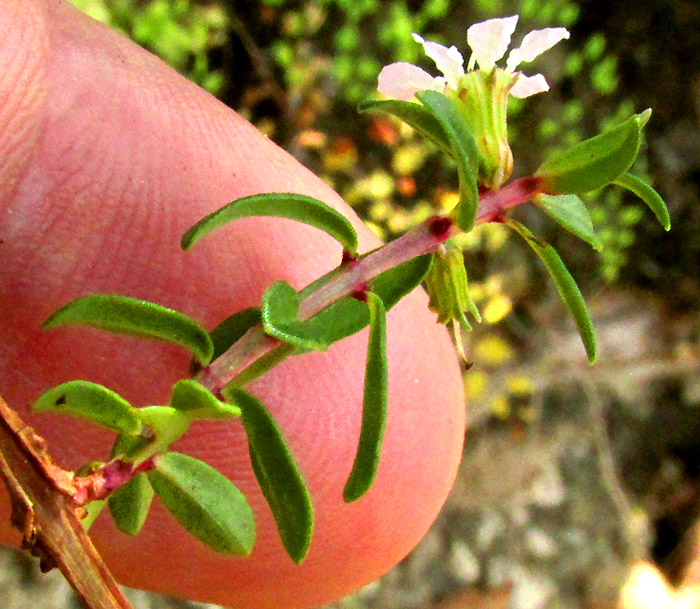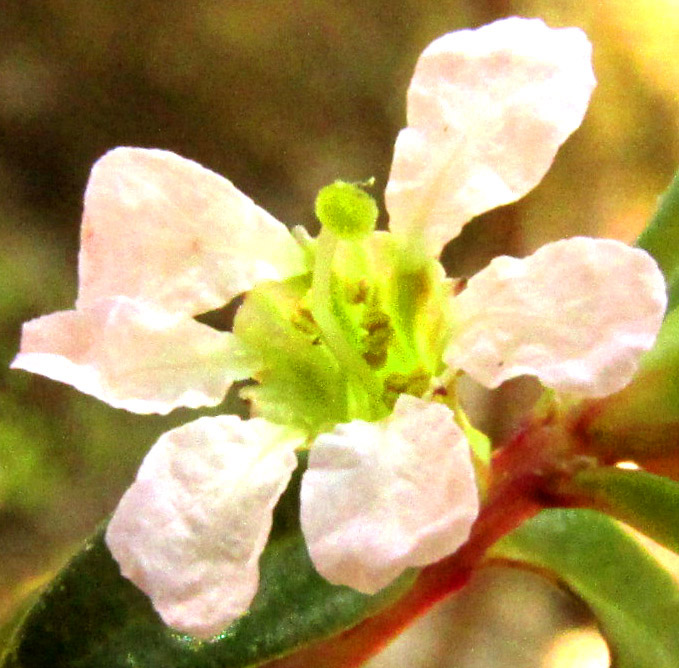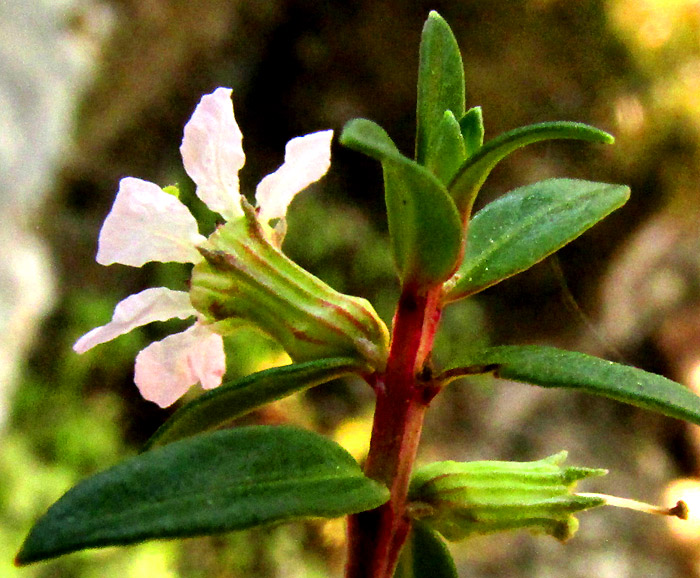Excerpts from Jim Conrad's
Naturalist Newsletter
Entry dated April 20, 2024, from notes taken about 1.5km northeast of Puerto de los Velazquez, Municipality of Pinal de Amoles; N21.138°, W99.665°, elevation ~2780 meters (~9120 feet); oak-pine borderline cloud-forest on limestone bedrock; in the Eastern Sierra Madre Mountains of east-central Querétaro state, MÉXICO
LYTHRUM GRACILE
 At the crest of a wind-swept ridge and at the base of an old roadcut through limestone rock, at the right, in the wind, my hand steadies a slender, stiff, leafless stem. At the stem's lower end, just below the cluster of maidenhair fern fronds, there's a short sprout emerging with green leaves and a single small flower, seen below:
At the crest of a wind-swept ridge and at the base of an old roadcut through limestone rock, at the right, in the wind, my hand steadies a slender, stiff, leafless stem. At the stem's lower end, just below the cluster of maidenhair fern fronds, there's a short sprout emerging with green leaves and a single small flower, seen below:

I'm unsure why the main stem looks snipped off and leafless. Possibly it was ravaged by an animal such as one of the area's roving cattle. Also, this region is experiencing an ongoing dry period which the North American Drought Monitor maps as a D4 Drought, the Monitor's droughtiest level, drier than during D2 Severe, and D3 Extreme Droughts.

The flower, only about 8mm across (⅜ inch), instead of the expected five petals, bore six. And the petals, instead of arising atop or below the ovary, grew from the rim of a pale green, urn-shaped, calyx-like "floral tube." Emerging from atop the ovary at the bottom of the tube, a bent style arose bearing a green, spherical stigma. Surrounding the style were six stamens.

Behind the blossom it's seen that the green floral tube is elongated, strongly ribbed, and below each petal stands a short, tooth-like sepal. The floral tube's base bulges asymmetrically. The reddish stem is strongly squared in cross-section, and leaves have no or very short petioles.
Gardeners and those who know their wildflowers may recognize these features as typical of certain members of the Loosestrife Family, the Lythraceae. In this part of upland, central Mexico known as the Bajío Region, four genera of the Loosestrife Family are represented. If your family member's flowers bear six white petals, it's either a cuphea such as the Cuphea aequipetala we've seen not far from here, or a loosestrife, like the Lythrum ovalifolium observed in Texas.
Among the 19 documented Cuphea species occurring in our area, none looks like our plant with its white flowers and leaves occurring in pairs at each stem node. Among the three Lythrum species, our plant matches features of LYTHRUM GRACILE.
Lythrum gracile is known by no English name, though all Lythrum species might be called loosestrifes. However, gardeners and wildflower people usually think of loosestrife species as bearing purplish flowers, and tending to live near water; our white-flowered loosestrife on a limestone ridge doesn't fit stereotypes.
The Flora del Bajío describes Lythrum gracile as the most commonly encountered and widely distributed Lythrum in Mexico. It occurs in uplands throughout the country, and extends into Guatemala. It frequents stream banks, open disturbed areas, depressions with puddles, moist soil on slopes, and ditches, so the species is flexible in its preferences. Our plant on a ridge often beset with cloud-mist may not have needed so much water at its roots.
The 2002 study by Luz del Carmen Navarro Pérez and Sergio Avendaño Reyes entitled "Flora Útil del Municipio de Astacinga, Veracruz, México," reports that the whole plant of Lythrum gracile is used to treat burns.